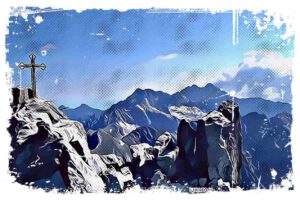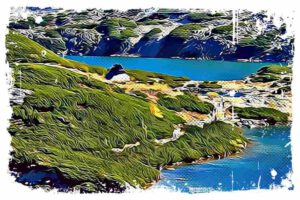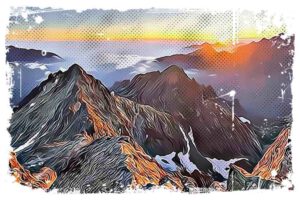Tatra Mountains are the great place for a memorable adventure, especially driving around it or road trips. These highest mountains in our region might seem small, as they stretch just over 55 km from one end to another, and are never wider than 17 km. However, they offer a truly unforgettable experience, thanks to their breathtaking landscape.

Driving around these majestic Tatra Mountains takes a bit longer than you might think. It’s best to allocate at least two days for this trip, as there are so many attractions to explore, enough to fill a guidebook of several hundred pages.
The Great Tatra Loop – A Scenic Road Trip Through the Tatra Foothills
I think it’s worth noting that the highest mountain range of the Carpathians, with its rocky peaks reaching for the sky, is mainly accesible to hiking tourists. But don’t worry. You can still enjoy the beauty of the Tatra Mountains through a scenic road trip called the „the great loop”. This approximately 200 km car route takes you through the foothills, passes, and mid-mountain depressions, making it one of the most beautiful excursion routes in this part of Europe.

The drive usually takes about 4.5-5 hours in normal weather conditions, but I am convinced that it’s worth spending much more time on this journey. If you want to fully appreciate the most important viewpoints, you’ll need an additional few hours, at least.
↳ Before you head to Tatra Park, I highly recommend reading my complete guide to Tatra Mountains. I showcase the most scenic places you won't want to miss. Make sure to check it out, so you don't overlook anything interesting: Tatra Mountains – An Insider’s Guide to All Attractions and Info
Attractions Galore – Caves, Museums, Spas, and More
Being there, you need to know that there are many other attractions to explore, such as caves, open-air museums, spas, and thermal pools. In winter, you can even visit several interesting ski stations. To get a taste of the most important attractions, you’ll need at least a weekend, but 3-4 days would be optimal.
- You may also want to read this: Planning Your Zakopane Trip: How Many Days Do You Need?
I can tell that finding accommodation won’t be a problem in the foothills of the Tatras. It is probably the best-developed region of the Carpathians, offering hotels, guesthouses, lodgings, and numerous fantastic inns and restaurants.
- If you are looking for the best spot, read this article: A Relaxing Vacation – 6 Great Areas Near Zakopane for Stay
Kicking Off My Adventure in Zakopane – The Winter Capital of Poland
I believe a great place to start your Tatra journey is Zakopane. Known as the „winter capital of Poland” for over a century, this bustling tourist town is a popular destination all year round. From Zakopane, we’ll head towards the border with Slovakia, in the area of Łysa Polana.
You can get there in two ways – either by the shorter Oswald Balzer road, which starts at the roundabout in Kuźnice and runs mainly through forests, or by taking a slightly longer route through Bukowina Tatrzańska. I highly recommend the second option, as it offers an incredibly scenic drive.
The Scenic Route – Bukowina Tatrzańska to Łysa Polana
Although it starts with a more strenuous stretch through the densely built-up valleys of the Podhale villages, the road becomes incredibly picturesque beyond Bukowina. The highlight of this route is the Głodówka glade, one of the best viewpoints of the Tatra Mountains. This makes the road from Zakopane to Łysa Polana a strong contender for the title of the most beautiful scenic road in Poland.

As you arrive in Łysa Polana through several winding serpentines, you’ll turn towards the bridge over the Białka River, which flows from the highest parts of the High Tatras. Take a moment to look to the right, towards the main ridge of the Tatra Mountains, where the mighty Gerlach pyramid towers over intricately carved cauldrons. It’s a truly high mountain scenery.
Unfortunately, the view of the high, jagged Tatra ridges doesn’t last long. The road takes a sharp turn and rises to a low, overgrown section, revealing the impresive silhouette of Murań, which marks the beginning of the massif of the Belianske Tatras’ ridge.
Exploring Jaworzyna and Prince Hohenlohe’s Wooden Palace
As we continue our journey, we descend to Jaworzyna. On the left side, within a vast clearing, you can catch a glimpse of the wooden palace of Prince Hohenlohe. He owned a large portion of the Tatra Mountains before the war. However, the modern shape of the Polana hotel, which once served as the government center for the Czechoslovak communists and later as a meeting place for Polish and Slovak officials, somewhat spoils the view.

We pass Javorina Spiska, and shortly after the forest settlement of Podspady, we begin the climb to the Zdziarska Pass, marking the northern end of the Tatra massif. Not far from the point where the road crosses its wide saddle, we emerge into the open. I know the view is so captivating and different from what we saw a few kilometers back that it’s worth stopping here. The shapely pyramids of Havran and the Crying Rock line up, creating a stunning backdrop for the mountains closer to us.
Ždiar – A Highland Village Rich in Folklore and Tradition
On the left side, you’ll soon see the buildings of the highland village of Ždiar. Famous for its well-preserved folk architecture and lively folklore, it’s also a favorite holiday spot for visitors from Poland.

Check the available accommodation by clicking here.
As we leave the village, we enter a narrow gorge of a stream winding its way between the Tatra Mountains and Magura Spiska. We pass the narrowest point, framed by rocks several dozen meters high, and soon arrive at the small health resort of Tatrzanska Kotlina, situated on the eastern border of the Tatra Mountains.
Discover the Wonders of Bielska Cave

If you want to explore one of the most beautiful caves in the Western Carpathians, I highly recommend stopping at Tatrzanska Kotlina (Tatra Valley) and visiting the local Bielska Cave. Interestingly, this cave had lighting installed as early as 1896, making it one of the first illuminated caves in Europe.
It is worth to say that Bielska Cave is famous for its beautifful dripstones, which include fanciful stalactites, stalagmites, draperies, and enchanting cave lakes. The length of the current route is 1,370 m, and the tour lasts 70 minutes, offering a truly magical experience.
Journeying Through the „Pearls” of the Tatra Resorts
As we leave the valley behind and turn right, we begin a long, gentle uphill stretch that, with minor breaks, continues for more than 30 km up to Štrbské Pleso. We’ll travel first on the eastern and then the southern slopes of the mountains, discovering the consecutive „pearls” of the Tatra resorts along the way.
Tatranská Lomnica – The Gateway to Lomnica Peak

Book your stay in one of these places by clicking here.
Our first stop is Tatranská Lomnica, one of the largest and most beautiful spas, nestled harmoniously at the foot of Lomnica, the second highest peak of the High Tatras. I think it’s worth taking a longer break here to enjoy a cable car ride to the peak of Łomnica. This thrilling journey from the lowlands to the peaks is considered by many visitors to Slovakia as the country’s greatest attraction.
Discovering Smokovec – The Oldest Resort in the Tatra Mountains
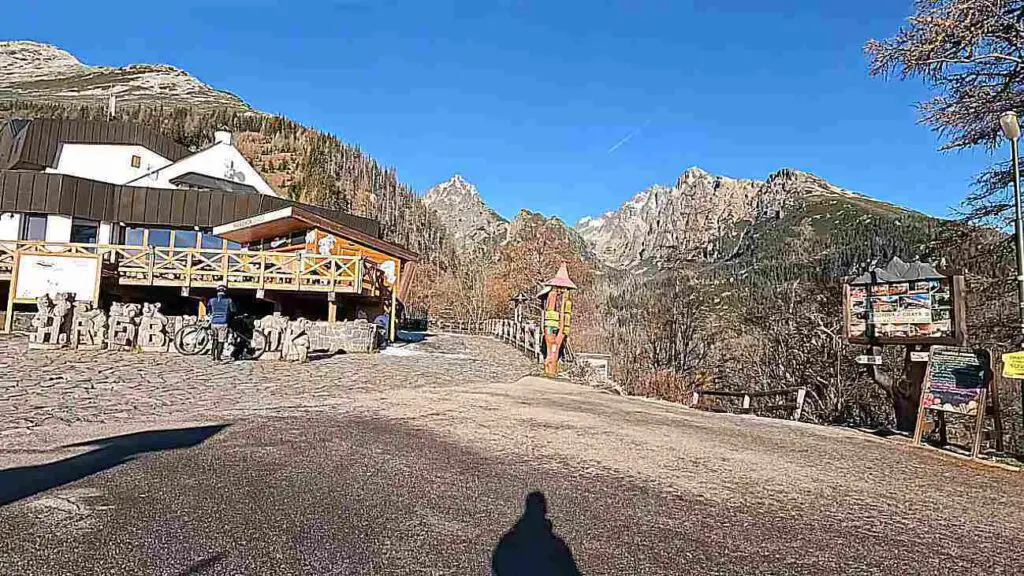
Here you can check the available rooms.
Just a few kilometers away, we find Smokovec – four housing estates merged into one, forming the oldest resort in the Tatra Mountains. I encourage you to take a stroll around the spa and admire the numerous beautiful examples of old guesthouses and hotels available for booking. If you’re up for another adventure, you can ride the funicular railway to Siodełko, also known as Hrebienok in Slovak, where trails to high mountain shelters begin. Keep in mind that these shelters are open even in winter, but you’ll need good shoes and should only plan a trip in favorable weather.
- You may also want to read this article: The Best Times of Year and Weather to Visit the Tatra Mountains
Marveling at the Tatra View and Štrbské Jezioro
After Smokovec, our journey continues to climb towards Štrbské Lake. On the right, we’re accompanied by stunning views of the Tatra, including Gerlach, with its characteristic cauldron, this time viewed from the south.

As we reach a crossroads, our main route heads west, but I recommend turning right to find ourselves in the center of Štrbské Jezioro. This incredibly picturesque village is the highest situated of the Tatra settlements, offering a unique perspective on the breathtaking landscape.
Štrbské Pleso – A Mountain Pond
Štrbské Pleso is not only the name of the village but also the mountain pond over which the resort buildings are spread. As the second largest pond in the Slovak Tatras, it is surrounded by beautiful spruce forests. Its uniqueness lies not only in its exceptionally beautiful landscape but also in its location on the European Watershed.
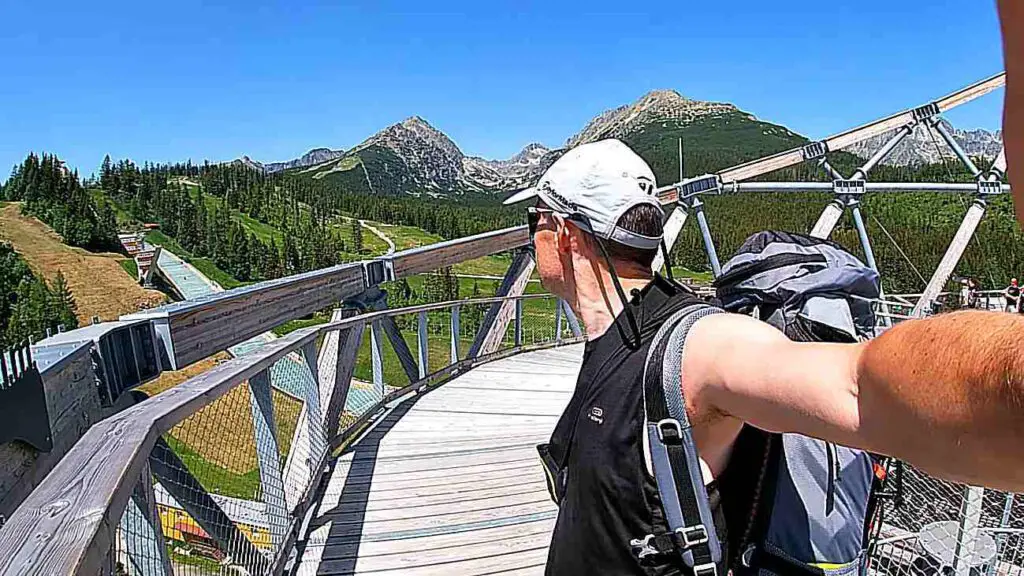
You can check available accommodation in Štrbské Pleso by clicking here.
Let me say, part of the water from the pond seeps into the Poprad, belonging to the Baltic Sea Basin, while the other part flows into the Vah, which is part of the Black Sea Basin. A 2-kilometer road surrounds the pond, offering a pleasant, 45-minute walk with views of the peaks reflecting in the water – unless it’s winter, and the lake is covered with a thick layer of ice.
Descending to Pribylina – A Glimpse of the Past
From this point, our route descends significantly. We pass Podbanska, a small settlement from which you can hike (trail closed in winter) to the famous Kriváň. As we reach the bottom of the vast Liptovská Basin, we arrive at Pribylina. I highly recommend visiting the local open-air museum, which houses many artifacts from towns submerged by the waters of Liptovska Mara lake. The open meadows and fields at the valley’s bottom offer stunning views of the Western Tatras from the south and the characteristic tilted Kriváň.
Liptovsky Mikulas – A City with a Colorful History

You can search for overnight location here.
Soon, we reach the motorway, which we follow for several kilometers before turning off to Liptovsky Mikulas. This large city, boasting a charming market square, a beautiful church, and several interesting museums, is primarily known as the place where the most famous Carpathian highwayman, Janosik, was executed. South of the city begins the renowned Demänovská Valley in the Low Tatras, adorned with two accessible caves – Freedom and Lodova. And at the valley’s end, on the slopes of Chopok, awaits the largest ski resort in Slovakia!
Exploring the Demänovská Valley
The Demänovská Valley in the Low Tatras offers visitors an immersive experience into the beauty and wonders of nature. The valley, adorned with two accessible caves, Wolności and Lodowa, has something for everyone – whether you’re seeking adventure, relaxation, or simply to enjoy the stunning landscapes.
Freedom Cave – A Subterranean Wonderland

Freedom Cave is a must-see attraction in the Demänovská Valley. Its vast chambers are adorned with spectacular stalactites, stalagmites, and flowstones, showcasing the incredible power of nature. The cave is open for guided tours, allowing you to delve into this subterranean world and admire its geological wonders up close.
Lodova Cave – A Journey into the Ice Age

The second accessible cave, Lodova Cave, offers a unique experience as you step into a frozen wonderland. With ice formations that have persisted for thousands of years, it’s like stepping back in time to the Ice Age. Guided tours are available, enabling you to witness the incredible ice sculptures and learn about the fascinating history of this natural marvel.
Chopok – Slovakia’s Premier Ski Resort
At the end of the Demänovská Valley, on the slopes of Chopok, you’ll find Slovakia’s largest ski resort. With its diverse range of slopes catering to skiers of all levels, it’s the perfect place for winter sports enthusiasts. Moreover, the resort offers a range of activities beyond skiing, including snowboarding, snowshoeing, and even dog sledding. And after an exhilarating day on the slopes, you can relax and recharge in one of the many cozy mountain huts, restaurants, and bars in the resort.
With so much to see and do in the Demänovská Valley, it’s no wonder that it has become a popular destination for visitors to the Tatra Mountains region. Whether you’re an avid adventurer, a nature lover, or simply seeking a picturesque escape, this enchanting valley has something to offer everyone.
Oravice – Relaxation in Thermal Springs
As you continue your journey, you’ll arrive at Oravice, a charming village renowned for its thermal springs. Two facilities await visitors seeking relaxation and rejuvenation – the old swimming pool and the modern Meander Park. The old swimming pool offers a more traditional experience with two small pools where you can simply enjoy the warm water. In contrast, Meander Park provides a more contemporary experience, featuring outdoor swimming pools and a spacious indoor swimming pool hall.
Chochołów – A Step Back in Time
Heading north from Oravice, you’ll soon reach the border and the quaint village of Chochołów. This picturesque village is known for its beautifully preserved wooden buildings, offering a glimpse into the region’s rich history and architectural heritage. It’s the perfect place to slow down and soak in the tranquil atmosphere as you stroll through the charming streets.
Zakopane – Returning Home
As your journey comes full circle, you’ll head south from Chochołów and pass by the famous valleys of Chochołowska and Kościeliska before returning to Zakopane. These stunning valleys offer an array of natural wonders and opportunities for exploration – another reason to return to the region in the future.
You may also want to read this article: Things to do in Zakopane When You Only Have One Day
Throughout this trip, you’ve discovered just a selection of the many attractions that the Tatra Mountains have to offer. The beauty of this region lies in its diversity and its ability to captivate visitors time and time again. Whether you choose to return for a second visit or continue exploring further afield, the Tatra Mountains will always have something new and exciting to offer.
References:
- https://polskiemarkiturystyczne.gov.pl/uploaded_files/eve_1588268260_przewodnik-rowerowy-etap-i.pdf

